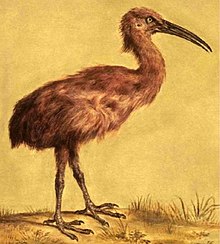Kuina
| Red rail | |
|---|---|
 |
|
| Painting of a possibly stuffed specimen attributed to Jacob Hoefnagel, ca. 1610 | |
| Scientific classification | |
| Kingdom: | Animalia |
| Phylum: | Chordata |
| Class: | Aves |
| Order: | Gruiformes |
| Family: | Rallidae |
| Genus: |
†Aphanapteryx Frauenfeld, 1868 |
| Species: | †A. bonasia |
| Binomial name | |
|
Aphanapteryx bonasia (Selys, 1848) |
|
 |
|
| Location of Mauritius (in blue) | |
| Synonyms | |
|
List
|
|
The red rail (Aphanapteryx bonasia) is an extinct species of flightless rail. It was endemic to the Mascarene island of Mauritius, east of Madagascar in the Indian Ocean. It had a close relative on Rodrigues island, the likewise extinct Rodrigues rail (Erythromachus leguati), with which it is sometimes considered congeneric. Its relationship with other rails is unclear. Rails often evolve flightlessness when adapting to isolated islands, free of mammalian predators.
The red rail was a little larger than a chicken and had reddish, hairlike plumage, with dark legs and a long, curved beak. The wings were small, and its legs were slender for a bird of its size. It was similar to the Rodrigues rail, but was larger, and had proportionally shorter wings. It has been compared to a kiwi or a limpkin in appearance and behaviour. It is believed to have fed on invertebrates, and snail shells have been found with damage matching an attack by its beak. Human hunters took advantage of an attraction red rails had to red objects by using coloured cloth to lure the birds so that they could be beaten with sticks.
Until subfossil remains were discovered in the 1860s, scientists only knew the red rail from 17th century descriptions and illustrations. These were thought to represent several different species, which resulted in a large number of invalid junior synonyms. It has been suggested that all late 17th-century accounts of the dodo actually referred to the red rail, after the former had become extinct. The last mention of a red rail sighting is from 1693, and it is thought to have gone extinct around 1700, due to predation by humans and introduced species.
...
Wikipedia

